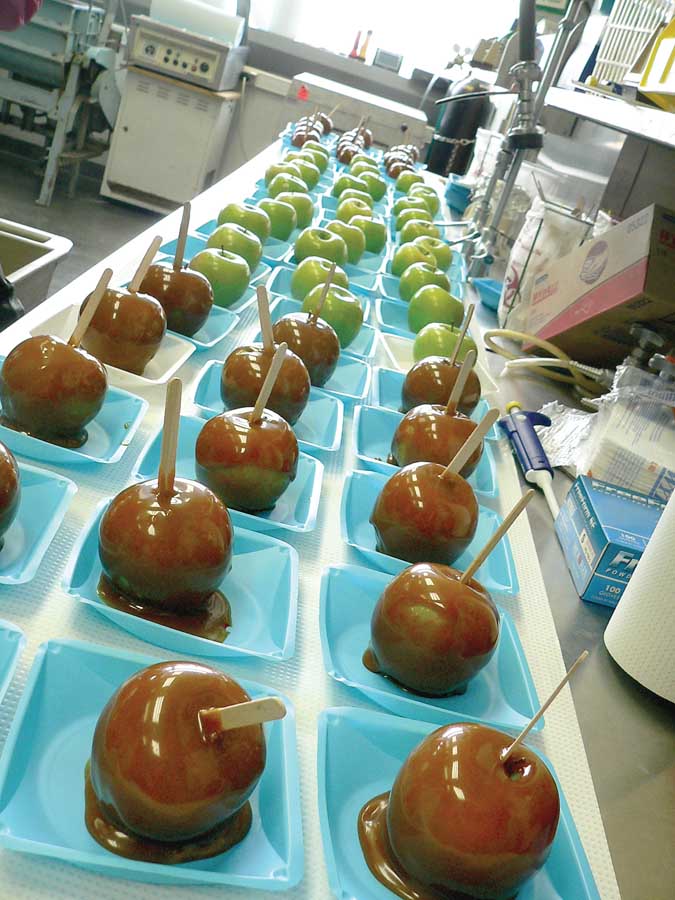
A member of Glass’s research group inoculates an apple with Listeria. The fruit is then used to make caramel apples, at which time they are tested for the bacteria. This provides insight into the potential for caramel apples to cause illness among consumers. (Courtesy Kathleen Glass)
Over the past year or so, whole genome sequencing has gotten a lot of attention as a means of pinpointing where an illness outbreak started, but what exactly is it and how does it work?
Whole genome sequencing is a tool to determine an organism’s full complement of genetic material, or the entire DNA sequence, in one fell swoop.
An organism’s DNA sequence is made up of building blocks, called nucleotides, that serve as the blueprint for that particular organism, whether it is a bacterium like Listeria or a human being.
The more closely two organisms are related to one another, the more similar their DNA.
Therefore, whole genome sequencing can be used to provide evidence in paternity suits, or to determine whether the bacteria causing a person’s foodborne illness is possibly the descendent of the bacteria found on machinery involved in making that food, or on the fresh fruit from an orchard.
Before whole genome sequencing was developed, scientists used other methods to tell organisms apart, but whole genome sequencing provides a much more detailed picture, said Kathleen Glass, distinguished scientist and associate director of the Food Research Institute at the University of Wisconsin–Madison.

Caramel apples that will be tested for Listeria. (Courtesy Kathleen Glass)
The process of whole genome sequencing involves breaking the DNA into snippets, simultaneously deciphering the string of nucleotides within each snippet, and then putting the information from all of the snippets in the right order to generate the entire DNA sequence end to end.
“Whole genome sequencing is very precise, which makes it far less likely that we would misidentify what the original source of a bacteria is than if we used one of the older methods,” Glass said.
Although whole genome sequencing has been around for at least a decade, it has only become a tool for pathogen tracking within the past year, she said.
“The reason it’s being used so much now is because the technology has gotten to be considerably more cost-effective. To do a sequence 10 years ago, it would have cost $50,000, but now it’s $1,000 or less.”
Often the cost today may fall below $600, noted Trevor Suslow, extension research specialist in the Department of Plant Sciences at the University of California.
He added that investigative analyses done by Centers for Disease Control and Prevention, the U.S. Food and Drug Administration and state labs also include other techniques that don’t require full genome sequencing and are even less expensive.
Whole genome sequencing is just one part of the arsenal used to identify the source of a pathogen. Investigators still rely on good, old-fashioned detective work and careful epidemiology to narrow the field of suspect foods and possible infection sites and, once that’s done, bring in whole genome sequencing to seal the case, Glass said.
That’s exactly what happened with the 2015 Blue Bell ice cream listeriosis outbreak, she noted. Investigators questioned patients and their families, looked for commonalities, and ice cream came to the top of the list.
“The only way they definitively tracked it down, though, was through whole genome sequencing: When they went back to the plants, they found Listeria, and matched it (to the patient samples). There was no doubt that was the source. Whole genome sequencing was the smoking gun.”
More from this story online:
- Protect your customers, protect your orchard
- Whole genome sequencing tracks pathogens, perhaps to your door
– by Leslie Mertz, Ph.D., is a freelance writer based in Gaylord, Michigan.






Leave A Comment